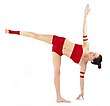Restorative Yoga
Restorative Yoga is the practice of asanas, each held for longer than in conventional classes, often with the support of props such as folded blankets, to relax the body.
Practice
An early disciple of B.K.S. Iyengar, the yoga teacher Judith Lasater, helped to create Restorative Yoga by 2007, based on Iyengar Yoga's asanas and use of props.[1][2][3]
Restorative Yoga sessions allow the body to slow down and relax in a small number of asanas. Each pose is held for longer than in conventional classes, sometimes for twenty minutes, so a session may consist of only four to six asanas. The long holding of poses is often assisted with props such as folded blankets, to ensure the body is fully supported and so to allow the muscles to relax.[4]
The martial arts coach Eric C. Stevens, stating that he found being still more difficult than a "five mile run", was surprised to start the Restorative Yoga class with Savasana (corpse pose), and to see so many props in use - blanket, pillow, eye bag, strap, blocks. He found his mind strongly challenged during the class, and he slept very soundly afterwards. He recommended the practice for people who feel close to burnout.[5]
Difference from Yin Yoga
Restorative Yoga is mainly for practitioners suffering from injuries, stress, or illness, who therefore require a yoga practice that can bring them back to a better quality of life; classes are necessarily small so that each person can receive detailed attention to ensure they are safe and properly supported. Yin Yoga uses props in a similar way, and holds poses for similarly long periods, but is aimed mainly at healthy practitioners, and is taught in larger classes.[6]
See also
References
- Isaacs, Nora (5 April 2007). "Exercisers Slow It Down With Qigong". The New York Times.
Judith Hanson Lasater, a yoga teacher since 1971 who now teaches restorative yoga, a form that encourages relaxation.
- Lasater 1995.
- Gates 2006, pp. 89–94.
- Pizer, Ann (24 March 2019). "An Introduction to Restorative Yoga". Very Well Fit. Retrieved 15 April 2019.
- Stevens, Eric C. "What the Heck Is Restorative Yoga and Why Should I Do It?". Breaking Muscle. Retrieved 15 April 2019.
- "Yin Yoga or Restorative Yoga?". Yin Yoga. Retrieved 15 April 2019.
Further reading
- Carey, Leeann (2015). Restorative Yoga Therapy : the Yapana way to self-care and well-being. New World Library. ISBN 978-1-60868-359-8. OCLC 890615522.
- Flamm, Sue (2013). Restorative Yoga with Assists : a manual for teachers and students of yoga. CreateSpace. ISBN 978-1-4936-8732-9. OCLC 902708490.
- Gates, Janice (2006). Yogini: Women Visionaries of the Yoga World. Mandala. pp. 89–94. ISBN 978-1932771886.CS1 maint: ref=harv (link)
- Grossman, Gail (2015). Restorative Yoga for Life : a relaxing way to de-stress, re-energize, and find balance. Adams Media. ISBN 978-1-4405-7520-4. OCLC 883207433.
- Hetherington, Michael (2013). How to Do Restorative Yoga: For Home Or in a Class. Amazon Digital Services. ISBN 978-0-9875584-9-7.
- Lasater, Judith (1995). Relax and renew : restful yoga for stressful times. Rodmell Press. ISBN 978-0-9627138-4-2. OCLC 33388596.CS1 maint: ref=harv (link)
- Lasater, Judith (2017). Restore and rebalance : yoga for deep relaxation. Shambhala. ISBN 978-1-61180-499-7. OCLC 975032763.
- Long, Nancy Hodge (2016). Restorative Yoga: Restful poses to cradle the body, comfort the heart, calm the mind. Crystal Heart Imprints. ISBN 978-0972100359.
- Norberg, Ulrica (2016). Restorative Yoga : reduce stress, gain energy, and find balance. Skyhorse Publishing. ISBN 978-1-5107-0530-2. OCLC 914219245.
